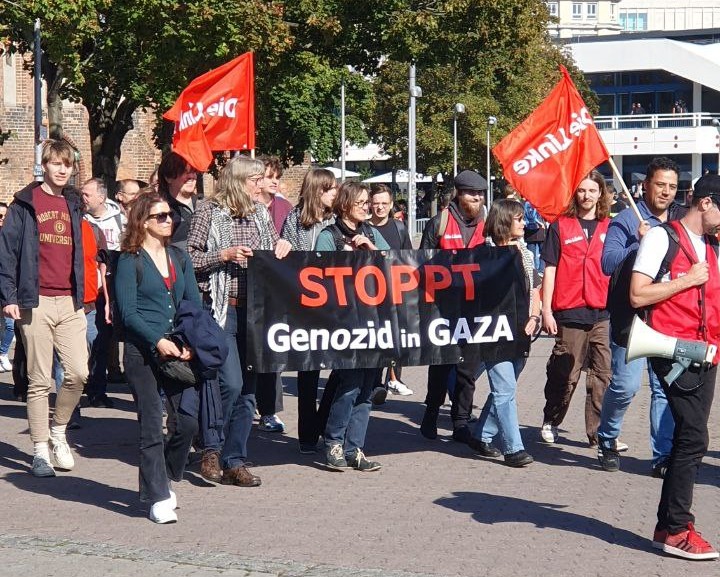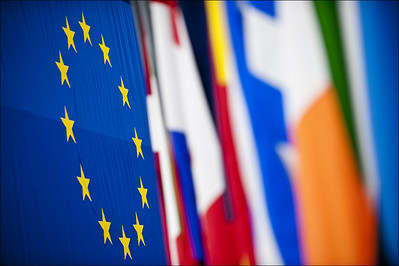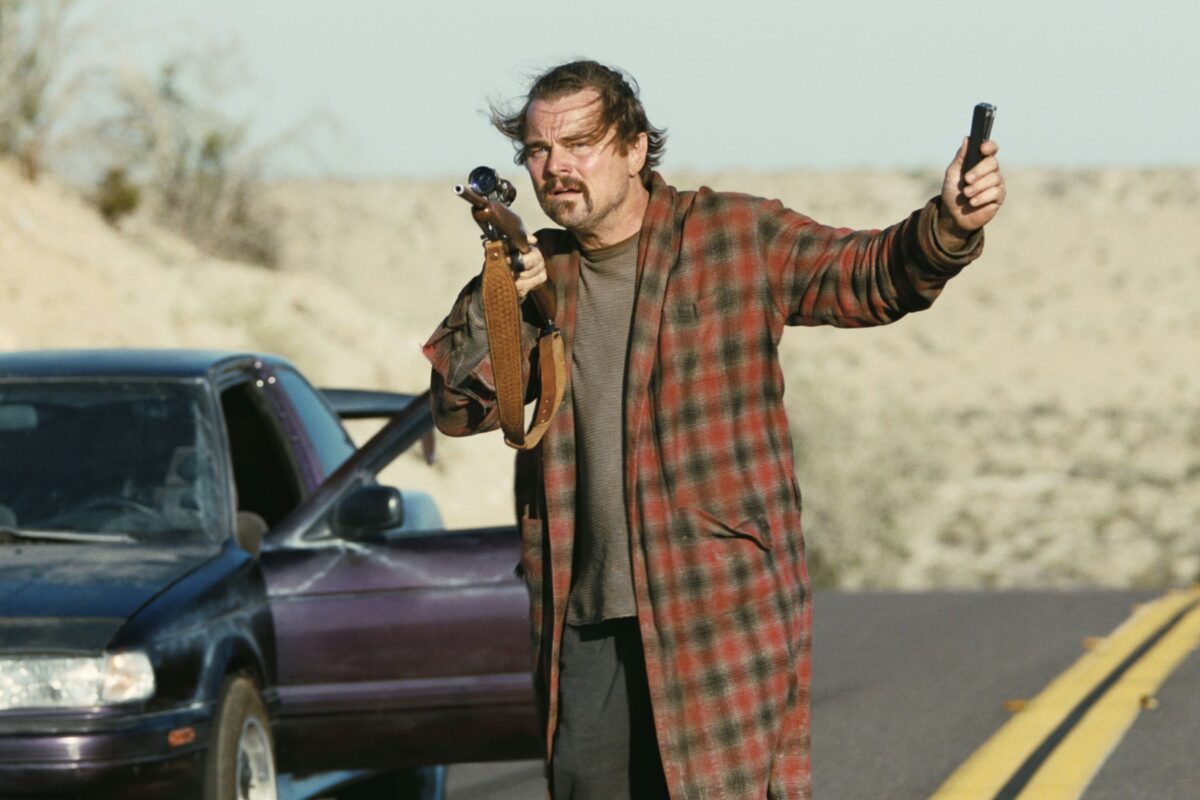In late August I visited the Beeskow Art Archive as part of a €9 day trip organised by Left Berlin. The Beeskow Art Archive preserves an extraordinary range of artistic production from the GDR; from huge mural-like panel paintings, bronze busts, still lives, to student projects, photography and ceramics. Both the collection, and how the archive was created gives us an insight into the role and conception of the culture and art of GDR, as well as bringing up the question of public ownership of material that was produced under a state system of patronage that no longer exists.
So what did cultural policy look like in the GDR? A look back at the Bitterfelder Weg conference of 1959 which introduced a new program of the socialist cultural policy in the GDR, can help reveal the origins of prevalence of public art as well as the role of art in Alltagskultur (everyday life culture). The conference was organised to look at how working people could be given access to art and culture, overcoming the “existing separation of art and life” through getting the working class more involved in the cultural project of socialism. Walter Ulbricht, the head of the SED party, initiated the slogan “Greif zur Feder, Kumpel, die sozialistische deutsche Nationalkultur braucht dich!” or, “Grab your pen, buddy, German socialist culture needs you!” This program attempted to place artists and writers in factories and other sites of mass production, to support workers in artist activity.
This in some ways mirrors the Worker Photography Movement which went against a representative mode of photographing working class movements, instead locating artistic production as part of or in aid of struggle. In the 1970s revival of Worker Photographer in London by photographer Terry Dennett, where he poses the distinction between, ‘workers’ photography, those movements in which Socialists and ordinary people have played an active and formative role, and the various bourgeois controlled practices which we have termed photography for the workers.
However, the Bittefelder Weg was soon abandoned, and in April 1964, cultures were instead given the task of promoting political education in socialist consciousness and key figures in socialism. Much of this was funded by the GDR Kulturfonds, a fund founded by FDGB, the Kulturbund, and the Department of Public Education, which acted as the commissioning body for most of the works that are housed in Beeskow Art Archive. A month before reunification, Herbert Schrimer, the final minister of Culture of the GDR and Walter Patig, the last director of DDR Kulturfonds formed a new foundation whose aim was to continue the public access to works funded by the Kulturfonds.
At this time the artworks were dispersed all over the GDR in the institution that they were commissioned for. After reunification those institutions would no longer exist, so a separate organisation that would continue after reunification was needed. Florentiner Nadolny, the director of the Archive, reminded us that there is no public art collection in West Germany that houses artists from the GDR. This ambivalence of GDR cultural heritage since reunification is only starting to change after a generational gap.
Up until the last five years or so, GDR cultural production was seen as socialist kitsch rather than serious artist work. Two current exhibitions that are helping shift this change in perspective are Kunstraum in Berlin, current exhibition Worin unsere Stärke besteht: Fünfzig Künstlerinnen aus der GDR, showcases the work of fifty women artists from GDR, and Künstlerinnen. Fotografien von Sibylle Fendt, which is housed within the Beeskow Art Archive.
As part of the visit we were given an excellent tour around the collection by Florentiner Nadolny ( which you can book here). Many of the brief insights in this article were inspired by Florentiner’s deep knowledge of the collection and I highly recommend it. I want to highlight a number of pieces from the tour which showed the breadth of aesthetics in GDR commissioned art despite a very much regulated system of state patronage, as well as how art permeated much of public and everyday life in the GDR. We were unable to take pictures in the Archive, so I have managed to source some pictures to give you a glimpse of the works.
There was so much interesting work to write about but I could not include them all, other artists that were of particular note on the tour were: Norbert Wagenbrett, Sibylle Fendt, Kostas Sissis, and Sabina Grzimek.
The fee for the commission was for around twenty-five thousand East German Marks which was the equivalent to around a year’s wages for an artist in the GDR… Although application to the professional organisation was highly controlled, once a member they ensured that cultural workers were properly paid and the art that became part of the state and mass institutions.
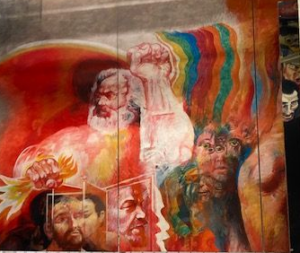
When entering the archive in Beeskow the room is full of grey metal plan chests full of drawings, prints and photographs. Above them hangs a huge painting, Aus dem Leben Ernst Thälmann (From the life of Ernst Thälmann) by Christian Heinze, which was commissioned in the early 1980s to be hung in the mensa of Free German Trade Union Federation (FDGB). A communal table in the centre of the canvas shows people from the GDR living a common life, above them a crowd of people and at the centre Ernst Thälmann, former leader of the Communist Party of Germany (KPD), with his fist raised high. Around the edges of the painting we see the Red Army defeating fascism, the destruction of Berlin and the building of industry in the GDR.
Due to the fact that most works in the Beeskow Art Archive were owned by the Free German Trade Union Confederation (FDGB) and other mass institutions, during the GDR they remained in the public sphere (as opposed to private collections). Art was not just confined to the gallery or museums, but seen as integral to building socialism, so sharing lunch with Ersnt Thälmann in mensa was very much part of the fabric and material culture of life.
The fee for the commission was for around twenty-five thousand East German Marks which was the equivalent to around a year’s wages for an artist in the GDR. These kinds of commissions were only available to artists who were members of the Verband Bildung (Artist’s Union) and were paid for by the GDR Kulturfonds. Although application to the professional organisation was highly controlled, once a member they ensured that cultural workers were properly paid and the art that became part of the state and mass institutions.
Am Strand (On the Beach) by Walter Womacka was painted in 1962… The painting was reproduced more than three million times as an art print, postcard and art calendar, as well as a stamp in 1968 had a circulation of twelve million.
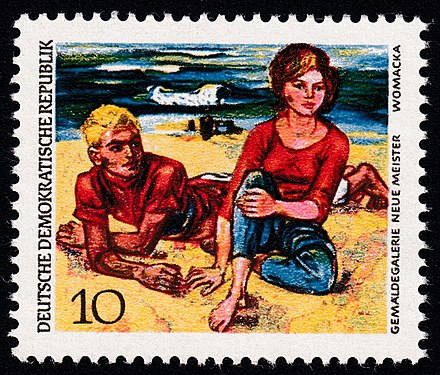
Hanging on the wall, right next to Aus dem Leben Ernst Thälmanns, were various versions of probably the most famous painting in the GDR. Far from portraits of Thälmann, bronzes of Lenin and or numerous tributes or Rosa Luxemburg and Karl Liebknecht, this intimate everyday picture struck a chord with the population. Am Strand (On the Beach) by Walter Womacka was painted in 1962 and was presented to Walter Ulbricht by the Politburo of the Central Committee of the SED on his 70th birthday. The picture shows two young people, perhaps not yet a couple, sitting on the beach, their middle fingers touching in an uncertain gesture of adolescent love.
Very much in a Socialist Realist style which elevated everyday life under socialism into a “revolutionary romanticism”, the painting through its circulation became a key to the people in GDR’s image of themselves. The painting was reproduced more than three million times as an art print, postcard and art calendar, as well as a stamp in 1968 had a circulation of twelve million. Indeed, one of our tour group remembered the painting from her parent’s sitting room.
Womacka was very much a ‘state artist’ and a member of the SED who was commissioned to do many commission in prominent GDR buildings, such as Unser Leben (Our Life) for the teacher’s house on Berlin’s Alexanderplatz and panel painting Wenn Kommunisten träumen (When Communists Dream) was hung in the Palace of the Republic. The latter was also reproduced as a stamp in 1981 (see below). The dramatic shift in style between Am Strand and Wenn Kommunisten träumen shows that even for ‘party artists’, art was neither uniform or simple functional within socialism.
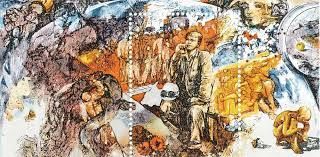
One of the most spectacular, and mildly grotesque pieces of the archive was a huge multi-canvas piece by renowned GDR artist Willi Sitte, entitled ‘“Proletarier aller Länder, vereinigt euch!’ or ‘ Workers of the World, Unite! Each section, mounted on sliding archival storage, was revealed individually due to the size of the piece. First came Marx; a lightning bolt grasped in one hand and the other lifted high as a fist radiating rainbow colours, below a small refracted side portrait of Lenin.
The next panel brings a sharp contrast between the austere sepia portraits of the figures of communism in Germany (Clara Zetkin, Rosa Luxemburg, Karl Liebknecht, and Ernst Thälmann) adorn the top of the picture, under this a baroque mass of bodies, muscles and guts. The people are tearing themselves down from the cross and heralding a new dawn with golden trumpets. Sitte, who deserted the Wehrmacht in 1944 and briefly went and fought for the Italian Partisans, and this style evidently resembles Italian Baroque.
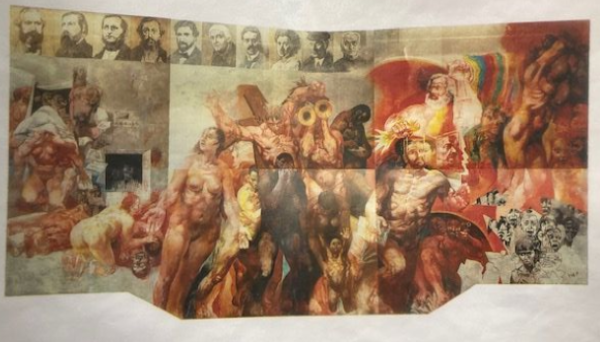
The final panel we were shown continued this lineage of communist figures with a young Marx and Engels in the left hand corner all the way through to Kautsky, under the canvas is grey with lumpen naked figures shrouded in cloth, newspapers emerge and fall from the grey background. They both form a revolutionary base, reminiscent of Willi Neubert’s Die Presse als Organisator (The Press as Organiser) mural on the Presse Cafe, in which the communist press takes on an activity and integral part of the revolutionary project.
Pieced together almost triptych-like murals portray the progression of revolutionary consciousness and mass politics from the beginning of the communist movement to what is assumed to imply state- socialism of the GDR. But far from the perhaps drab social realism that one might associate with ‘socialist’ art, the end panel shows a psychedelic mass of colour, power of collective action and the strength of people rising. Interestingly though this was not deemed a fitting piece to be displayed in the Parteihochschule in Köllnischer Platz by SED officials. Due to the prevalence of naked people in the painting the piece was hung at the top of the main staircase in the school and covered by a curtain. Florentiner Nadolny, the director of the Art Archive in Beeskow, said that this was suspected to be due to GDR relations with the Soviet Union. Sitte objected to it being covered up and attempted to buy the painting back through a public campaign, after much conflict the piece was permanently displayed.
This example of the top down sanctioning of even their most prominent artists (from 1974 to 1988 Sitte was President of the Association of Visual Artists of the GDR), showed the rhetoric of the Bitterfelder Weg had become highly institutionalised. However, like many of the contradictions that come out of the GDR, the conditions in which art was produced there can not simply be dismissed. The art in the Beeskow Art Archive emerges, not just as a top down expression of social values, but a site of struggle and negotiation around what it means to create socialist culture. The collections in Beeskow are testament to the huge variety and vibrancy of art that came out of GDR, and their work is key to reasserting it’s artistic and cultural heritage back into public view.


